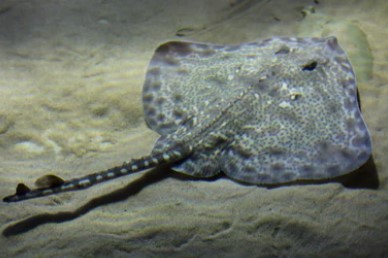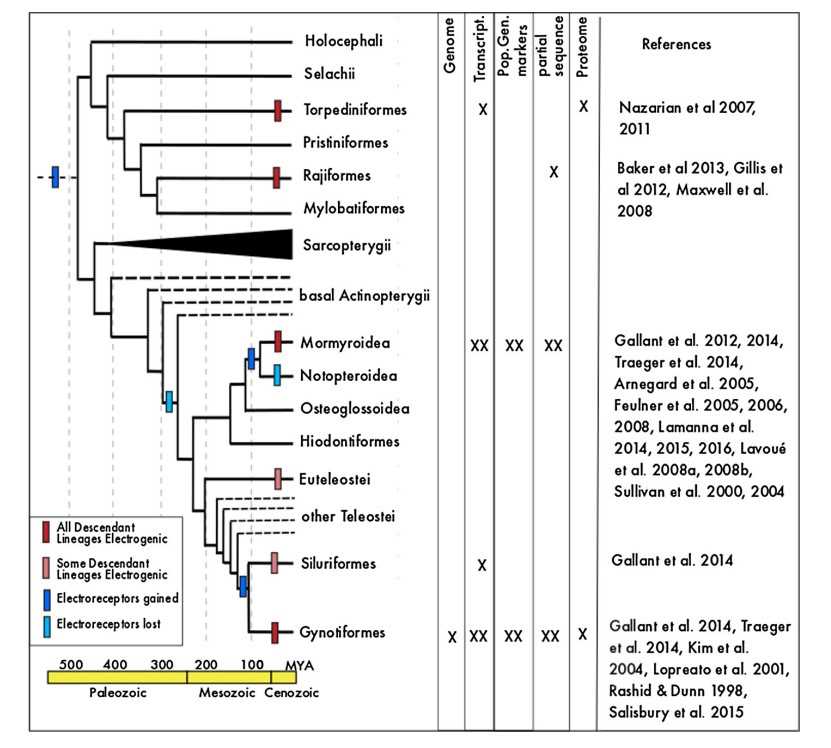Six groups of extant fishes can generate electricity: Rajiformes, Batoids, Siluriformes, Gymnotiformes, Ostekolossidae, and Uranoscopiformes, for a total of no less than 500 species. Each of the six taxa has evolved its independent power-generating organ. The public is familiar with the electric eel, electric ray, and electric catfish. These voltages are large enough to have the ability to attack and defend, collectively known as "strongly electric fish" in addition, there are a large number of fish that can only release a weak current, collectively known as "weakly electric fish", their discharge is mainly for detection or communication.
 Figure 1. A weakly electric fish called the Spotted ray (Raja montagui).
Figure 1. A weakly electric fish called the Spotted ray (Raja montagui).
The origin of the electric fish as a microcosm of evolution and its power generation construct represents an essential class of evolutionary phenomena that brought new functions to organisms: functional expansion. Since the discovery of electric fish, an increasing number of scientists have conducted research in the fields of evolutionary biology, cell physiology, development, systems and circuit neuroscience, ecology, and fish behavior. With the publication of the electric fish genomic resources, gene editing techniques have been widely used to study electric fish, uncovering the link between genotype and phenotype.
 Figure 2. Distribution of existing genomic data for electric fish. (Constantinou, S. J, et al. 2019)
Figure 2. Distribution of existing genomic data for electric fish. (Constantinou, S. J, et al. 2019)
As a professional biotechnology company, Lifeasible has extensive experience and insight in fish gene editing. We provide you with a complete electric fish gene editing technology service to help you explore the target gene's function and more.
Weakly electric fish have a vital biological role, being able to use short-range inductance to understand the spatial layout of their environment, allowing underwater navigation, object classification, and intraspecific communication. It can also detect the quality of the surrounding water through the discharge frequency of its electronic organs, with detection limits down to the nanomolar range. You can use our existing CRISPR/Cas9 systems to probe electric fish's behavioral and electrical production patterns. For example, we offer CRISPR/Cas9 technology to study the role of the Na+ channel gene scn4aa in the discharge process.
How the electric cells of electric fish generate, electricity is a fascinating and peculiar question. Its membrane has many tiny protein channels that selectively allow sodium (Na+) and potassium ions (K+) to flow in and out of the cell. We utilize the CRISPR/Cas9 system to help you validate genes associated with electricity production. We injected CRISPR/Cas9 together with the designed sgRNAs into electric fish embryo cells and screened the offspring of successful knockout of scn4aa after incubation to verify the firing amplitude of electric organs.
 Figure 3. Overview of CRISPR/Cas9 mutagenesis workflow.
Figure 3. Overview of CRISPR/Cas9 mutagenesis workflow.
Our CRISPR/Cas9 gene editing technology platform for electrofishing will help you not only in the relationship between target genes and phenotypes but also in breeding, genetic relationship analysis, and other studies. For more information or any inquiry request, please contact us.
Reference